Doing Science At the Oregon Institute of Marine Biology
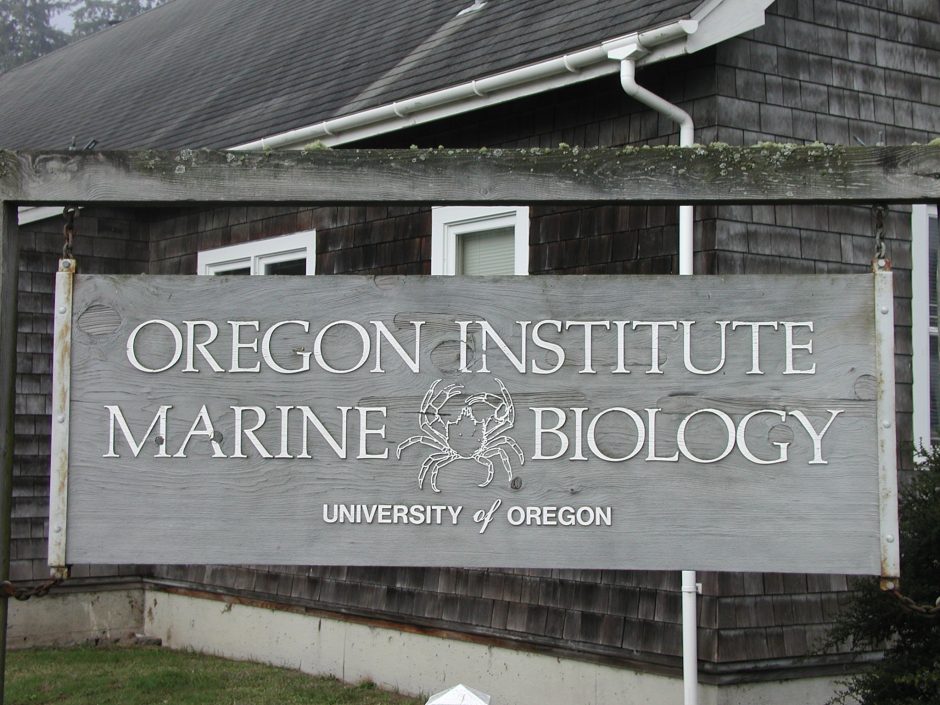 Welcome to OIMB. (Credit: OIMB, via source)
Welcome to OIMB. (Credit: OIMB, via source)For almost a century, researchers and students from the University of Oregon (UO) have been doing marine science on the coast of Southern Oregon. The Oregon Institute of Marine Biology (OIMB) has stood in its permanent location for nearly as long, providing unique opportunities for students and scientists alike. OIMB Education Coordinator Dr. Maya Watts spoke with EM about the lab and the educational and research activities housed there.
Life and learning at OIMB
UO researchers first began to research and teach near Sunset Bay in 1924, with tents for laboratories. By 1929, the university had a permanent site chosen for the lab, and in 1931, when land was deeded to the school, former Army Corps of Engineers buildings in the area became the first lasting OIMB structures.
Today, both year-round research and educational programs are carried out at the facility.
“We’re the University of Oregon’s marine lab,” explains Dr. Watts. “We have seven resident faculty that teach and conduct research at OIMB. Another is based on main campus in Eugene but has a lab and conducts research at OIMB.”
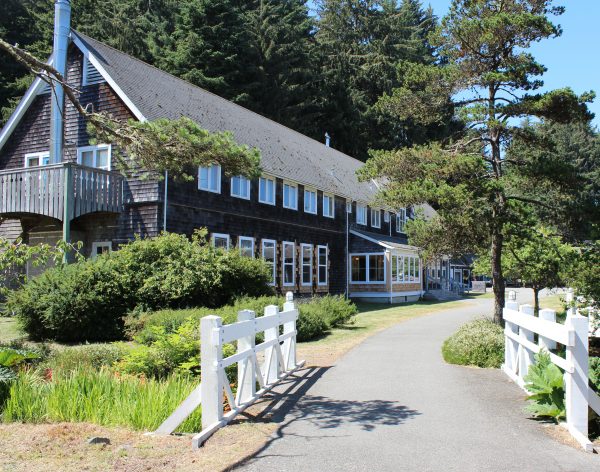
The OIMB dining hall. (Credit: OIMB, via source)
The OIMB’s location is itself a unique feature.
“We’re a distance from the main campus, two and a half hours from Eugene, which means that our graduate students and faculty live here year-round,” details Dr. Watts. “They all go to main campus for meetings and occasionally to teach, but mostly our faculty and our students are here for the whole year.”
The advantage to having a full-time resident population at the field station is a real sense of community and camaraderie, for students and researchers alike.
“The really nice thing about that is that it becomes this tight-knit community in which everybody knows everybody well. Plus there’s an open-door policy where students can just walk in and talk to professors at any time,” remarks Dr. Watts.
Classes take place at OIMB in the spring, summer, and fall terms, and anywhere from 20 to 70 students will be studying at the field station for any given term. Life at OIMB is itself unique and offers an intensive experience for marine biology majors.
“Summer is our busiest term with spring and fall terms having slightly fewer students,” comments Dr. Watts. “Our marine biology majors make up the bulk of the students as they are required to be at the marine lab for one full academic year, three terms. But we get many students from other majors at the UO and visiting students from other institutions,” Dr. Watts describes. “Most marine science programs require a term or two at a marine lab, but here they have to have a full year. Our classes are full-day classes, so instead of a normal biology class which might take place three times a week for 50 minutes, plus a three-hour lab, here, each class is one full day, every week.”
This schedule allows a class to physically go out to observe low tide first thing in the morning, and then return to the lab for a lecture, for example.
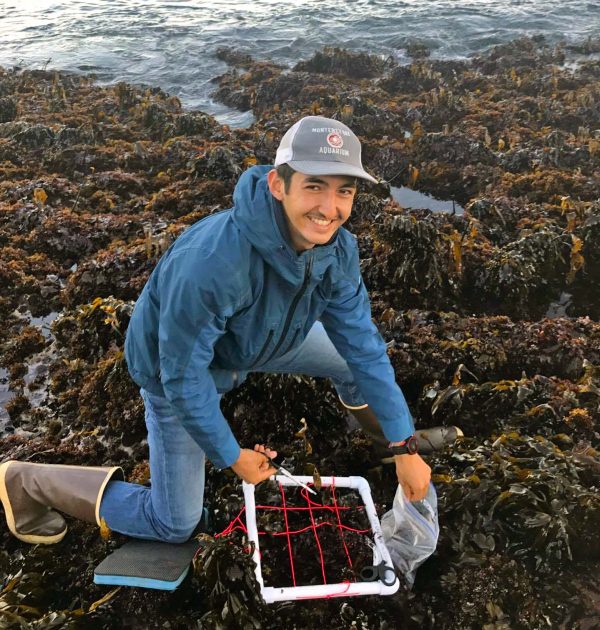
Exploring a tidal pool near OIMB. (Credit: OIMB, via source)
“It makes it much more of an immersion experience because they’re spending all day with their professor and their TA, and their peers,” states Dr. Watts. “They live in the dorms, and they’re usually on a meal plan, so they’re kind of living and breathing marine biology while they’re here. Most of our students came to the UO for the marine biology program. They are excited about coming to OIMB and don’t want to leave after they’ve been here. They’re used to having that small class, hands-on, field-based experience.”
OIMB offers a variety of courses, ranging from biological oceanography, embryology and larval ecology, to invertebrate zoology, biology of fishes, and marine birds and mammals and many others. The field station offers practical courses in marine conservation, technique courses in molecular marine biology, statistics and experimental design, and habitat-based courses in estuarine biology and deep sea biology. Students even get a chance to travel with the OIMB team.
“We also have a tropical marine biology in Panama course, where groups of students develop projects ahead of time and then go down to Panama for two weeks,” adds Dr. Watts. “There, they implement their group projects, analyze their data and present their findings in the form of scientific posters.”
In addition to formal education, the University of Oregon’s aquarium and museum, the Charleston Marine Life Center, is just across the street from OIMB. This provides a great venue for K-12 classes and visitors of all ages to see and touch marine life from our local waters, to learn about the life histories of marine organisms and the importance of our local fisheries. It is also just a great location to gaze up at whale skeletons and sneak a peek at a Giant Pacific octopus. The CMLC also provides an opportunity for OIMB students to learn more about science outreach, engagement with a public audience and skills in animal husbandry and aquarium science.
Research at OIMB
Although education and teaching are a high priority at OIMB, the professors at the station are also full-time researchers.
“All our professors love working at the marine lab, because you get small classes, 10 or 15 students, 20 if the class is full, but never 50 or a hundred at a time, so it’s kind of a luxury,” Dr. Watts says. “In addition, there are many marine habitats nearby that are relatively pristine—tide pools, mudflats, salt marshes, sand dunes, and beaches. We also have research vessels and a small ROV, so we can check out the sub-tidal population, too. It’s a really wonderful place for access to habitats for doing research and for taking students out on field trips, and everything’s close enough that it’s really accessible when you’re here.”

(Left) OIMB student holding an octopus. (Center) A striped dolphin dissection. (Right) A student holding a sea star.
Biological oceanographer Dr. Alan Shanks is researching Dungeness crabs.
“In his lab, Dr. Shanks does oceanography related to early life history stages, larval and young stages, including how they get from place to place, and what happens when they settle,” explains Dr. Watts. “One of his major projects is working on the Dungeness crab, our local crab fishery species. He and his team have collected baby crabs in light traps for over a decade to help predict what the crab fishery catch is going to be like a few years down the line from the number of babies caught in the light trap.”
This research may also help scientists and policymakers better plan for a future of food-scarcity, in which aquaculture is likely to play an increasingly important role.
“People in Dr. Shanks’s lab have also been developing fishery techniques for gooseneck barnacles, a real delicacy in many places,” states Dr. Watts. “They’re looking into how to grow them in aquaculture since they’re mostly found intertidally, and they’d be easy to over-harvest. They’ve been working on answering questions such as, how do we grow these things in the lab? How much food and how much water flow do they need to make them viable?”
OIMB’s Director, Dr. Craig Young, focuses on reproduction in the deep sea. This means that he conducts research in various ocean basins studying a range of habitats, and so do OIMB students.
“In part, he works on chemosynthetic communities that exist at hydrothermal vents and methane seeps, that use sulfur or methane bubbling up from the ocean floor to sustain life since they can’t access any sunlight for photosynthesis,” comments Dr. Watts. “He’s studied how larvae develop, and whether they travel long distances to the surface waters to feed, or whether they stay down there at the bottom and how far they can move between patchy habitats in the deep sea.”
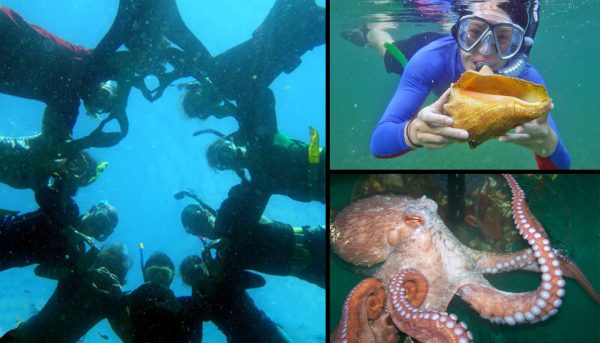
(left) Panama students on a dive (top right) A student diving, holding a sea snail. (bottom right) An 8-legged resident of OIMB. (Credit: OIMB, via source)
Dr. Young has worked in the Gulf of Mexico, on the East Pacific Rise, on canyons off the east coast of the U.S., in the Lau Basin and in soft-bottom communities such as those in the Bahamas.
“Craig writes teaching into his grants as well, where students have taken his courses, and then have been able to go on a deep sea cruise and be part of the research team on that cruise,” adds Dr. Watts.
Dr. Svetlana Maslakova, another OIMB faculty member, works on nemerteans (ribbon worms), unsegmented worms.
“They’re a phylum in their own right and some of them have a distinctive, interesting larval stage, and a catastrophic metamorphosis during which the developing juvenile eats the larval body from within,” remarks Dr. Watts. “Dr. Maslakova studies larval development in these worms and the genetics behind that development using cool tools, such as confocal microscopy to visualize their development. Also, she is a systematist and the world expert on nemerteans, traveling to distant places to study the biodiversity of the phylum.”
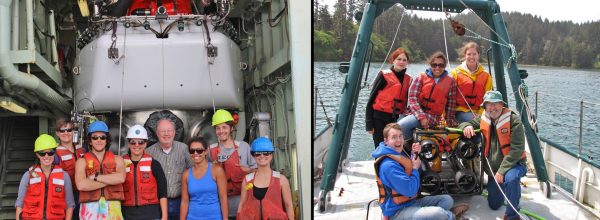
(Left) Image: OIMB researchers on an outing. (Right) Students and faculty near the OIMB’s ROV. (Credit: OIMB, via source)
While extensive educational and research opportunities exist at OIMB, Dr. Watts sees even more inherent value in the facility and the community that has developed there and at other marine labs.
“Really important discoveries in the world came from people working at marine labs. For example, many of the particulars on how fertilization works (from sea urchin eggs) and how electrical excitability and nerve action potential works (using giant axons in squid) were discoveries made by scientists working at marine labs,” comments Dr. Watts. “New innovations, or techniques for being able to visualize things that before we couldn’t see are now available because of the research that goes on at marine labs. So, there’s a lot of value, not only in the research itself but in teaching the next generations of scientists in small field-based courses how to formulate their own sorts of questions. The contribution of marine labs such as OIMB to our future is substantial.”




0 comments